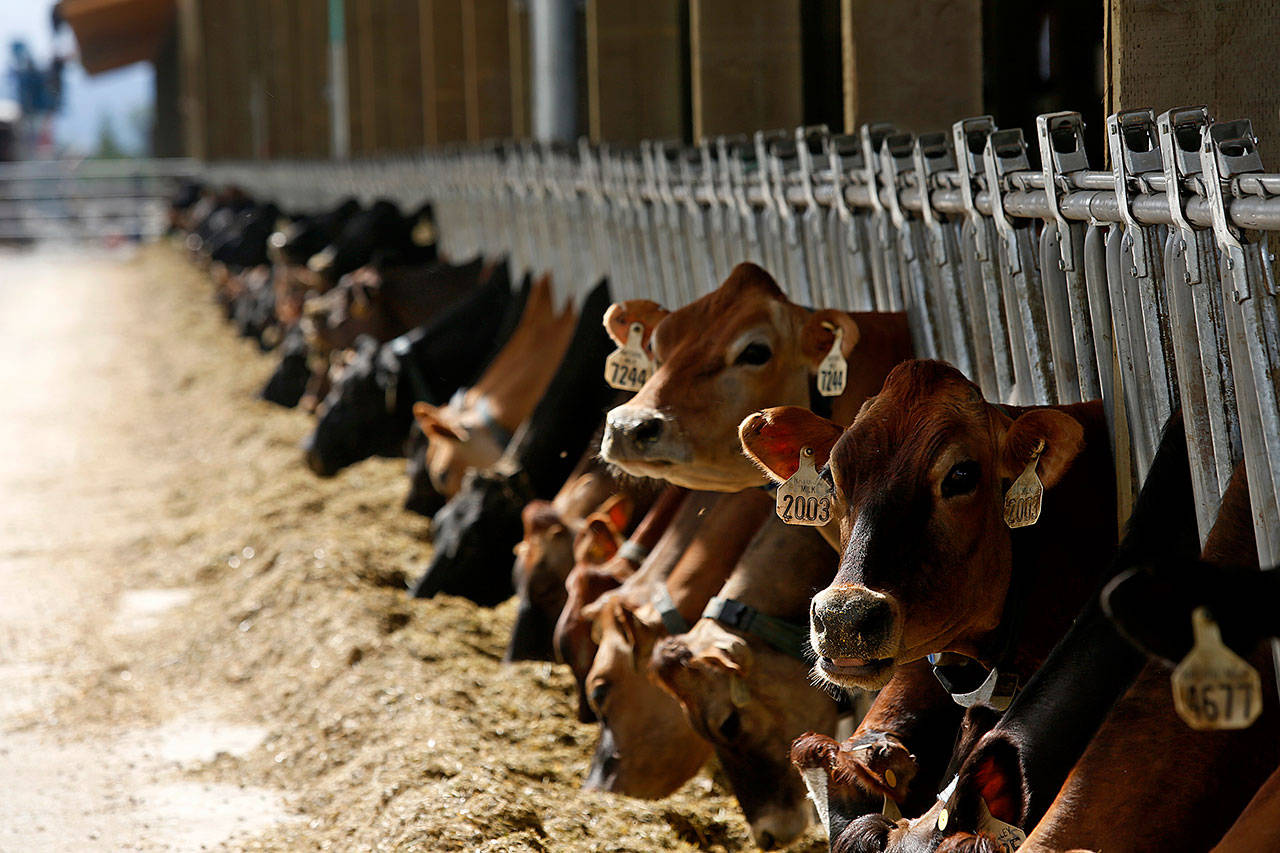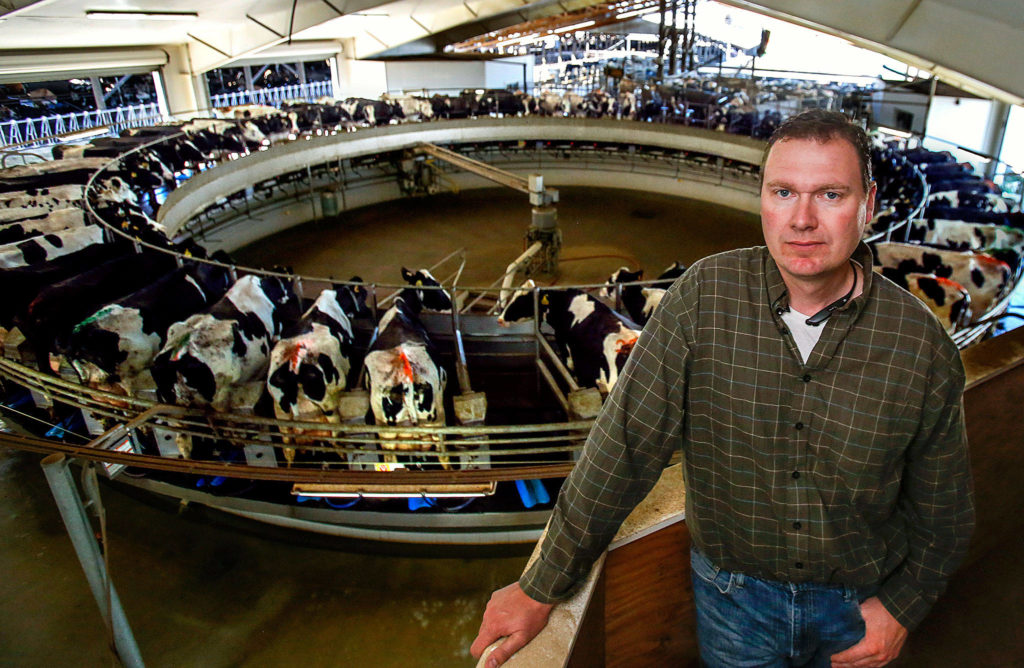By Paul Roberts / The Seattle Times
For fifth-generation dairyman Jeremy Visser, 2014 was a record-breaker. Amid soaring global demand for U.S. milk products, Visser made about $500 on each of the 4,000 cows he was running in Stanwood and four other Western Washington dairy operations.
But a year later, as those sweet trade conditions began to sour, Visser’s fortunes also turned. In both 2016 and 2017, milk prices fell so low that Visser lost $100 on each cow. By 2018, the per-cow losses topped $300.
Visser pulled through, in part by mortgaging “everything I owned.” But at least 50 dairy farmers he knows have left the business. The last few years “have been tremendously difficult on us,” says the 42-year-old father of three.
Visser could be speaking for most of the roughly 350 dairy farmers still in business in Washington, which as recently as 2007 boasted more than 800 dairy farms, according to the U.S. Department of Agriculture.
Dairy is the state’s third-most valuable farm product, after apples and wheat, with $1.2 billion in annual sales. But the business has been particularly vulnerable to economic shifts linked to changing consumer tastes, over-production, environmental regulation, and, more recently, global trade politics.
As a result, a sector known for its booms and busts has grown more volatile. That has forced survivors to adopt new strategies, with some shifting to smaller niche markets, while others try to grow their way out of declining incomes.
With trade relations still uncertain, and with some farmers struggling to repay loans taken out during the four-year price slump, the state dairy sector faces numerous hurdles, says Shannon Neibergs, an extension economist at Washington State University. Among bankers who lend to farmers, Neibergs says, “the dairy portfolio is recognized as their highest risk.”
To be clear, Washington’s dairy sector is faring better than big dairy players elsewhere in the U.S.
Wisconsin has lost some 1,600 dairy farmers in the last three years alone, according to the state’s department of agriculture.
Many of the nation’s big milk processors are also hurting. Dallas-based Dean Foods, the biggest U.S. milk producer, filed for bankruptcy protection in November, and Borden Dairy Co., also in Dallas, followed suit this month.
One big problem for Borden and Dean: Americans are drinking less milk even as they’re eating more cheese, butter, and other milk byproducts.
By contrast, the Pacific Northwest’s biggest processor, Seattle-based Darigold, is still seeing sales increases. Part of the reason is that the farmer-owned cooperative, which processes milk from Visser and 428 other members of the Northwest Dairy Association in Washington, Oregon, Idaho, and Montana, focuses more on high-demand products — including bulk cheese and butter, whey protein and dried milk — than on liquid milk.
In its 2019 fiscal year, Darigold reported net sales of $2.3 billion, up nearly 8 percent from 2017.
Still, net sales are down more than 11 percent from 2015. And Darigold’s membership has continued to shrink — its Washington contingent has fallen from 412 in 2006 to 294 this year.
The ranks of dairy farmers everywhere will probably keep falling, in part, because they are often better at producing milk than finding places to sell it.
With a steady stream of new technologies — including ones that focus on milking, breeding, nutrition and genetics — dairy farmers have seen impressive gains in output. From 1993 to 2018, milk yields from the average Washington dairy cow climbed 25 percent, to more than 12 tons, according to the USDA. And unlike many other businesses, where output often can be adjusted for changing demand, a dairy farm cannot simply idle a herd if prices fall.
“It’s very hard to turn a cow off,” Visser jokes.
But all that new milk has put downward pressure on milk prices — and on dairy farm incomes.
For years, many dairy farmers — especially those at smaller operations — have taken off-farm jobs to help their businesses survive and “keep doing what they love doing,” says Dan Wood, executive director of the Washington State Dairy Federation.
Some dairy farmers have adopted new business models that rely less on maximizing volume.
At the Twin Brook Creamery in Lynden, just south of the Canadian border, Larry Stap, a former Darigold member — and Visser’s distant cousin — has refashioned his dairy business around smaller batches of high-end “craft” milk.
While most commercial dairies use the high-output Holstein breed, Stap’s 200 Jerseys produce less milk, but it contains more butterfat and other solids — and, Stap says, more flavor. That’s a key selling point for his products, which include whole and other milks, fresh cream, and sweetened milks.
Yet even with Stap’s niche, he hasn’t ignored big industry changes.
To control costs in the Northwest’s tight labor market, Stap began switching to robotic milkers in 2015. The machines, which let cows give milk as often as they like, have reduced his labor costs and personnel headaches.
“They’re never late to work and they’re never hung over,” Stap jokes.
But they’re not cheap: each milker costs $200,000, and Stap’s herd needs four.
Much of the innovation in the dairy industry has focused on scaling up, not down. Visser’s dairy enterprise, for example, has roughly doubled since 2014 as many of his friends, neighbors, and others have sold their operations to him on their way out of the business.
That greater size has advantages. A larger operation lets farmers spread costs over more cattle. And a bigger revenue stream makes it easier to pay for those robotic milkers and other technologies — including systems to manage the dairy industry’s other big “output”: each Holstein cow generates 115 pounds of manure every 24 hours.
But going large has downsides, too. Greater output and falling milk prices — they dropped 32 percent between 2014 and 2018 — puts more pressure on dairy farmers to find new ways and places to sell their milk. In some cases, that has meant developing new consumer products. Darigold, for example, has introduced a higher protein, lower-sugar milk, called Fit, which CEO Stan Ryan says is “moving people from things like almond milk back into dairy milk.”
Increasingly, however, Northwest dairies have looked abroad to offload their extra output. From 2000 to 2014, Washington’s dairy exports jumped from $32 million to $232 million. In 2018, the most recent year for which data is available, Washington exported more than a seventh of its total dairy output by dollar value, according to the USDA. The share is even higher at Darigold, which exports 40 percent of its output and hopes to top 50 percent in the near future.
Washington state’s proximity to Asian trading partners gives state dairy producers a key advantage over Midwestern competitors. “We can get products to China or Singapore cheaper than we can get them to Chicago,” Ryan says.
Darigold has invested heavily in boosting its exports — for example, by producing more powdered milk, which is in high demand overseas — and is counting on exports for three quarters of future sales growth.
But relying more on foreign buyers can be risky. From 2014 to 2018, the dollar value of Washington dairy exports plummeted 24 percent as trade disputes cut overseas sales, according to the USDA. Federal relief payments to farmers hurt by the disputes — projected to be around $9.7 million for 2019 — will cover only a fraction of the losses.
The trade disputes also appear to have extended the milk price slump. Though milk prices rose through much of 2019, they’re still 8 percent below the 2014 peak.
The recent rapprochement on trade between the U.S. and China, and the U.S. Senate’s ratification of the American trade pact with Canada and Mexico, have raised industry hopes for a boost in U.S. dairy exports. But trade tensions could easily resurface.
And some of America’s dairy trade partners aim to rely less on U.S. imports. “Russia and China are building their own internal dairy supply,” Neibergs says.
Visser expects more turmoil for the industry. By 2021, he thinks the milk market will likely shift back to its typical 3-year price cycle, where dairy farmers “make money for a year, break even for a year, then lose a lot of money.”
Although 2020 will be a good year, Visser says, “I’m positive that’s about all we’ll get.”
Talk to us
> Give us your news tips.
> Send us a letter to the editor.
> More Herald contact information.


























